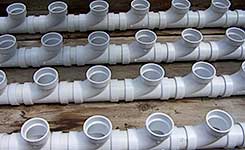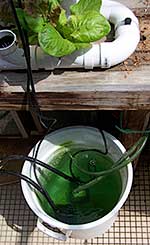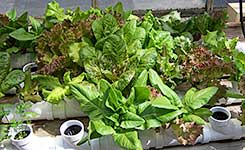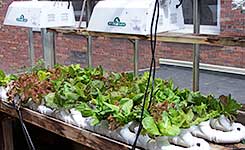 Nutrient-Flow-Through Hydroponic System
Nutrient-Flow-Through Hydroponic System
 |
| Hydroponic array before planting. |
|
 |
 |
| Close-up of bucket containing pumps, nutrient solution, and drain hoses. |
|
 |
 |
| Heirloom lettuce 2.5 months after planting. |
|
 |
 |
| Completed installation. |
|
This project enabled us to introduce a nutrient-flow-through (NFT) hydroponic system, with lighting, to the BHS greenhouse. The system allows us to grow lettuce, both as a demonstration and as a student activity in our Environmental Science class. We also use the system as an Environmental Club activity. It's a good example of how to grow food out-of-season, and how to reduce our carbon footprint caused by growing and shipping lettuce long distance. It is important to note that the operation of a hydroponic system is not "free" -- it requires electricity for the pumps and lights, and heat during cold months!
Funding provided by BEF and the BHS Science Department budget enabled us to purchase the materials required for construction of the hydroponic system and installation of the lighting. Construction of the system was begun in August, and lights were installed by the BHS custodial staff in September. Construction and final "tuning" of the hydroponic system were completed by January. The greatest difficulty turned out to be the "tuning" -- adjusting flow rates in (the pumps) and out (the drain hoses) such that the system neither overflowed nor supplied insufficient nutrient solution (water with fertilizer). As the plants grow, their roots begin to obstruct the channels, so regular adjustment of flow rates is important.
The first crop we planted was heirloom lettuce, because previous experiments had shown that lettuce was well suited to the cool temperatures of the BHS greenhouse. The hydroponic system grows plants in two 4x13 arrays (52 plants, each). Plants are positioned about 6 inches apart. Water and fertilizer is recirculated through each 52-plant array using small statuary pumps. Light is provided using "grow lights" on 12-hour timers. Plants grow to harvest size in a couple of months, depending on temperature.
Other teachers, staff, and community members involved in this project were:
- Lynn Sanger (special education teacher and local farmer)
- Dick Tschorke (technology teacher)
- Rob Luce (BHS head custodian)
- Frank Novelli (BHS custodian)
- Jesscia Beh (French teacher and local organic farmer)
- Brian Beh (local organic farmer)
- Walt Nelson (Cornell University Cooperative Extension)

story and photos by George Smith
July, 2009


Brighton Education Fund

c/o Brighton Schools, 2035 Monroe Avenue, Rochester, New York 14618
voice (716) 461-0434 fax (208) 975-7494





